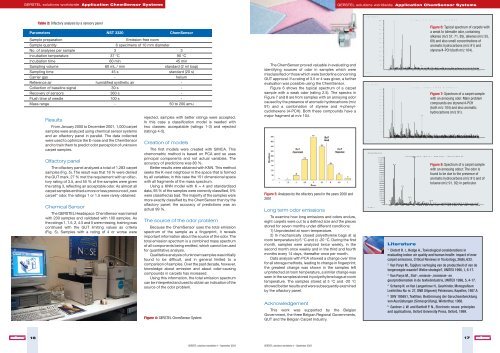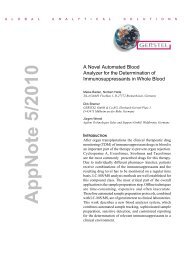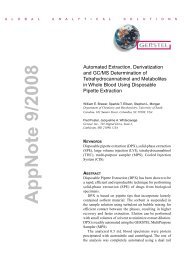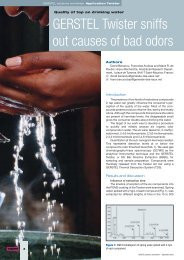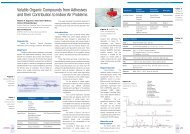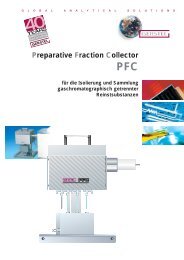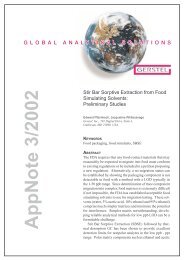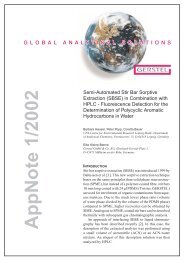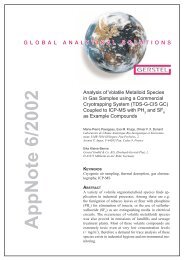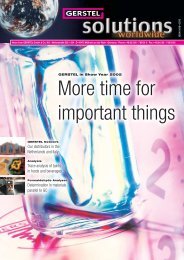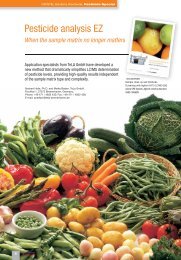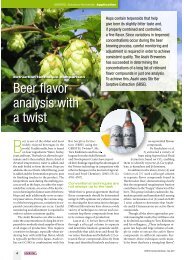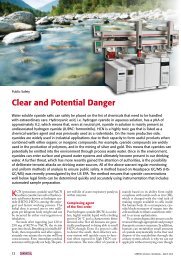GERSTEL Solution no 4
GERSTEL Solution no 4
GERSTEL Solution no 4
Create successful ePaper yourself
Turn your PDF publications into a flip-book with our unique Google optimized e-Paper software.
<strong>GERSTEL</strong> solutions worldwide Application ChemSensor Systems<br />
<strong>GERSTEL</strong> solutions worldwide Application ChemSensor Systems<br />
Table 2: Olfactory analysis by a sensory panel<br />
Parameters NST 3320 ChemSensor<br />
Sample preparation<br />
Emission-free room<br />
Sample quantity<br />
6 specimens of 10 mm diameter<br />
No. of analyses per sample 3 3<br />
Incubation temperature 37 °C 90 °C<br />
Incubation time 60 min 45 min<br />
Sampling volume 60 mL / min standard (2 ml loop)<br />
Sampling time 45 s standard (20 s)<br />
Carrier gas - helium<br />
Reference air humidified synthetic air -<br />
Collection of baseline signal 30 s -<br />
Recovery of sensors 360 s -<br />
Flush time of needle 100 s -<br />
Mass range - 50 to 200 amu<br />
Results<br />
From January 2000 to December 2001, 1,000 carpet<br />
samples were analyzed using chemical sensor systems<br />
and an olfactory panel in parallel. The data collected<br />
were used to optimize the E-<strong>no</strong>se and the ChemSensor<br />
and to train them to predict odor perception of unk<strong>no</strong>wn<br />
carpet samples.<br />
Olfactory panel<br />
The olfactory panel analyzed a total of 1,283 carpet<br />
samples (Fig. 5). The result was that 18 % were denied<br />
the GUT mark, 27 % met the requirement with an olfactory<br />
rating of 3.5, and 55 % of the samples were given<br />
the rating 3, reflecting an acceptable odor. As almost all<br />
carpet samples emitted a more or less pro<strong>no</strong>unced „new<br />
carpet” odor, the ratings 1 or 1.5 were rarely obtained.<br />
Chemical Sensor<br />
The <strong>GERSTEL</strong> Headspace ChemSensor was trained<br />
with 200 samples and validated with 100 samples. As<br />
the ratings 1, 1.5, 2, 4.5 and 5 were missing, training was<br />
continued with the GUT limiting values as criteria<br />
(Fig. 5). Samples with a rating of 4 or worse were<br />
rejected, samples with better ratings were accepted.<br />
In this case a classification model is needed with<br />
two classes: accepatable (ratings 1-3) and rejected<br />
(ratings 4-5).<br />
Creation of models<br />
The first models were created with SIMCA. This<br />
chemometric method is based on PCA and so uses<br />
principal components and <strong>no</strong>t actual variables. The<br />
accuracy of predictions was 80 %.<br />
Better results were obtained with KNN. This method<br />
seeks the K-next neighbour in the space that is formed<br />
by all variables; in this case the 151 dimensional space<br />
with all fragments of the mass spectrum.<br />
Using a KNN model with K = 4 and standardized<br />
data, 95 % of the samples were correctly classified, 5%<br />
were classified as bad. The majority of the samples were<br />
more exactly classified by the ChemSensor than by the<br />
olfactory panel; the accuracy of predictions was an<br />
actual 99 %.<br />
The source of the odor problem<br />
Because the ChemSensor uses the total emission<br />
spectrum of the sample as a fingerprint, it reveals<br />
important information about the source of the odor. The<br />
total emission spectrum is a combined mass spectrum<br />
of all components being emitted, which can<strong>no</strong>t be used<br />
for quantitative analysis.<br />
Qualitative analysis of unk<strong>no</strong>wn samples was initially<br />
found to be difficult, and in general limited to a<br />
comparison of samples. Over the past decade, however,<br />
k<strong>no</strong>wledge about emission and about odor-causing<br />
compounds in carpets has increased.<br />
Using this information, the total emission spectrum<br />
can be interpreted and used to obtain an indication of the<br />
source of the odor problem.<br />
Figure 4: <strong>GERSTEL</strong> ChemSensor System<br />
The ChemSensor proved valuable in evaluating and<br />
identifying sources of odor in samples which were<br />
misclassified or those which were borderline concerning<br />
GUT approval. If a rating of 3.5 or 4 was given, a further<br />
evaluation was possible using the ChemSensor.<br />
Figure 6 shows the typical spectrum of a carpet<br />
sample with a weak odor (rating 2.5). The spectra in<br />
Figure 7 and 8 are from samples with an an<strong>no</strong>ying odor<br />
caused by the presence of aromatic hydrocarbons (m/z<br />
91) and a combination of styrene and 4-phenylcyclohexene<br />
(4-PCH). Both these compounds have a<br />
major fragment at m/z 104.<br />
Figure 5: Analyses by the olfactory panel in the years 2000 and<br />
2001<br />
Long term odor emissions<br />
To examine how long emissions and odors endure,<br />
eight carpets were cut to a defined size and the pieces<br />
stored for seven months under different conditions:<br />
1) Unprotected at room temperature.<br />
2) In mechanically closed polyethylene bags at a)<br />
room temperature b) 5 °C and c) -20 °C. During the first<br />
month, samples were analyzed twice weekly, in the<br />
second month once weekly and in the third and fourth<br />
months every 14 days, thereafter once per month.<br />
Data analysis with PCA showed a change over time<br />
for all storage methods, leading to change in fingerprint;<br />
the greatest change was shown in the samples left<br />
unprotected at room temperature, a similar change was<br />
seen in the samples stored in polyethylene bags at room<br />
temperature. The samples stored at 5 °C and -20 °C<br />
showed better results and were subsequently examined<br />
by the olfactory panel.<br />
Ack<strong>no</strong>wledgement<br />
This work was supported by the Belgian<br />
Government, the three Belgian Regional Governments,<br />
GUT and the Belgian Carpet Industry.<br />
Figure 6: Typical spectrum of carpets with<br />
a weak to tolerable odor, containing<br />
alkanes (m/z 57, 71, 85), alkenes (m/z 55,<br />
69) and also small concentrations of<br />
aromatic hydrocarbons (m/z 91) and<br />
styrene/4-PCH (both m/z 104).<br />
Figure 7: Spectrum of a carpet sample<br />
with an an<strong>no</strong>ying odor: Main problem<br />
compounds are styrene/4-PCH<br />
(both m/z 104) and also aromatic<br />
hydrocarbons (m/z 91).<br />
Figure 8: Spectrum of a carpet sample<br />
with an an<strong>no</strong>ying odour: The odor is<br />
found to be due to the presence of<br />
aromatic hydrocarbons (m/z 91) and of<br />
toluene (m/z 91, 92) in particular.<br />
Literature<br />
1<br />
Dietert R. r., Hedge A., Toxicological considerations in<br />
evaluating indoor air quality and human health: impact of new<br />
carpet emissions, Critical Reviews in Toxicology, 26(6), 633.<br />
2<br />
Van Parys M., Tapijten: verhoging van de productiveit of van de<br />
toegevoegde waarde? Welke strategie?, UNITEX 1996, 1, 6-17.<br />
3<br />
Van Parys M., Stof-, emissie-, immissie- en<br />
geurproblematiek in de textielindustrie, UNITEX 1996, 5, 4-17.<br />
4<br />
Schamp N. en Van Langenhove H., Geurhinder, Mo<strong>no</strong>grafieen<br />
Leefmilieu Nu nr. 27, DNB Uitgeverij Pelckmans, Kapellen, 1987.A<br />
5<br />
SNV 195651, Textilien; Bestimmung der Geruchsentwicklung<br />
von Ausrüstungen (Sinnesprüfung), Winterthur, 1968.<br />
6<br />
Gardner J. W. and Bartlett P. N., Electronic <strong>no</strong>ses: principles<br />
and applications, Oxford University Press, Oxford, 1999.<br />
16<br />
17<br />
<strong>GERSTEL</strong> solutions worldwide 4 – September 2003<br />
<strong>GERSTEL</strong> solutions worldwide 4 – September 2003


